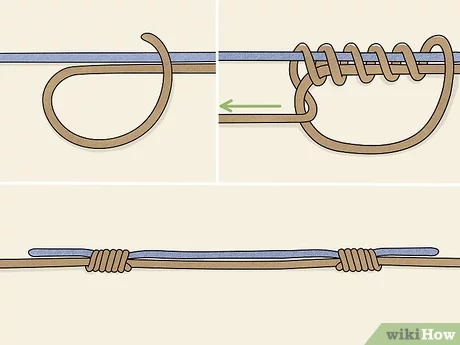How to Tie Two Fishing Lines Together
Tying two fishing lines together is a crucial skill for anglers to master. Whether you need to connect your main line to a leader, add more line to your reel, or repair a broken line, knowing how to create a strong, secure knot is essential for successful fishing. In this comprehensive guide, we’ll explore several effective methods for tying fishing lines together, including the uni knot, surgeon’s knot, albright knot, and double uni knot. We’ll also discuss the advantages and disadvantages of each knot and provide step-by-step instructions to help you master these techniques.
The Uni Knot
The uni knot is one of the most popular and versatile knots for connecting fishing lines. It’s easy to tie, creates a strong bond, and can be used with a variety of line types, including monofilament, fluorocarbon, and braided lines.
How to Tie the Uni Knot
- Overlap the two lines you want to connect, leaving several inches of each end exposed.
- Make a loop with one of the lines and wrap the tag end around both lines and through the loop 5-7 times, depending on the line thickness.
- Moisten the knot with saliva or water and pull both ends to tighten it down.
- Trim the tag ends close to the knot.
The uni knot is an excellent choice for tying a leader to your main line or connecting two pieces of line of the same material. It’s also a good option for creating a loop at the end of your line for attaching lures or swivels.
The Surgeon’s Knot
The surgeon’s knot is another popular choice for joining fishing lines. It’s particularly useful when connecting lines of different diameters, such as a heavy main line to a lighter leader.
How to Tie the Surgeon’s Knot
- Overlap the two lines you want to connect, leaving several inches of each end exposed.
- Make a loop with both lines and thread the tag end of one line through the loop.
- Wrap the tag end around both lines and through the loop 2-3 times.
- Moisten the knot with saliva or water and pull both ends to tighten it down.
- Trim the tag ends close to the knot.
The surgeon’s knot is a good choice for tying lines of different materials or diameters together, as it creates a secure connection that is less likely to slip. It’s also a good option for creating a loop at the end of your line for attaching lures or swivels.
The Albright Knot
The albright knot is a specialized knot used for connecting braided line to monofilament or fluorocarbon leader material. It creates a smooth transition between the two lines, reducing the risk of tangles and improving casting performance.
How to Tie the Albright Knot
- Make a loop with the thicker line (braided line) and thread the tag end of the thinner line (monofilament or fluorocarbon) through the loop.
- Wrap the tag end around the thicker line 10-15 times, depending on the line thickness.
- Thread the tag end back through the loop and moisten the knot with saliva or water.
- Pull both ends to tighten the knot down.
- Trim the tag ends close to the knot.
The albright knot is an excellent choice for connecting braided line to a leader, as it creates a strong, smooth connection that is less likely to break or tangle. It’s also a good option for creating a loop at the end of your line for attaching lures or swivels.
The Double Uni Knot
The double uni knot is a variation of the uni knot that creates an even stronger connection between two lines. It’s particularly useful for tying braided line to monofilament or fluorocarbon leader material, as it can withstand the added stress of fighting large fish.
How to Tie the Double Uni Knot
- Overlap the two lines you want to connect, leaving several inches of each end exposed.
- Make a loop with one of the lines and wrap the tag end around both lines and through the loop 5-7 times, depending on the line thickness.
- Repeat step 2 with the other line, wrapping the tag end in the opposite direction.
- Moisten the knot with saliva or water and pull both ends to tighten it down.
- Trim the tag ends close to the knot.
The double uni knot is an excellent choice for tying braided line to a leader, as it creates a strong, secure connection that is less likely to break or tangle. It’s also a good option for creating a loop at the end of your line for attaching lures or swivels.
Advantages and Disadvantages of Each Knot
| Knot | Advantages | Disadvantages |
|---|---|---|
| Uni Knot | Easy to tie, versatile, strong | May not be as smooth as other knots |
| Surgeon’s Knot | Good for connecting lines of different diameters | Can be bulky |
| Albright Knot | Smooth connection, good for braided line to leader | Requires more wraps |
| Double Uni Knot | Very strong, good for braided line to leader | More complex to tie |
Frequently Asked Questions (FAQ)
1. What is the best knot for tying two fishing lines together?
The best knot depends on the specific situation, but the uni knot, surgeon’s knot, albright knot, and double uni knot are all excellent choices that create strong, secure connections.
2. Can I use the same knot for tying braided line to monofilament?
Yes, the albright knot and double uni knot are both effective for connecting braided line to monofilament or fluorocarbon leader material.
3. How do I know which knot to use?
Consider the type and diameter of the lines you are connecting, as well as the specific application. The uni knot and surgeon’s knot are good all-purpose choices, while the albright knot and double uni knot are better suited for connecting braided line to a leader.
4. How do I ensure my knot is strong?
Always moisten the knot with saliva or water before tightening it down, and make sure to trim the tag ends close to the knot. Practicing each knot can also help you tie them more securely.
5. Can I use these knots for attaching lures or swivels?
Yes, many of these knots can be used to create a loop at the end of your line for attaching lures, swivels, or other terminal tackle.
Additional Information
| Fact | Source |
|---|---|
| Tying fishing lines together is a crucial skill for anglers. | Wikipedia – Fishing Knot |
Conclusion
Mastering the art of tying fishing lines together is an essential skill for any angler. By understanding the various knots available and their specific applications, you can create strong, secure connections that will help you land more fish and enjoy a more successful fishing experience. Whether you choose the uni knot, surgeon’s knot, albright knot, or double uni knot, practice and patience are key to tying each knot effectively. With this guide as a reference, you’ll be well on your way to becoming a knot-tying expert and taking your fishing game to the next level.



